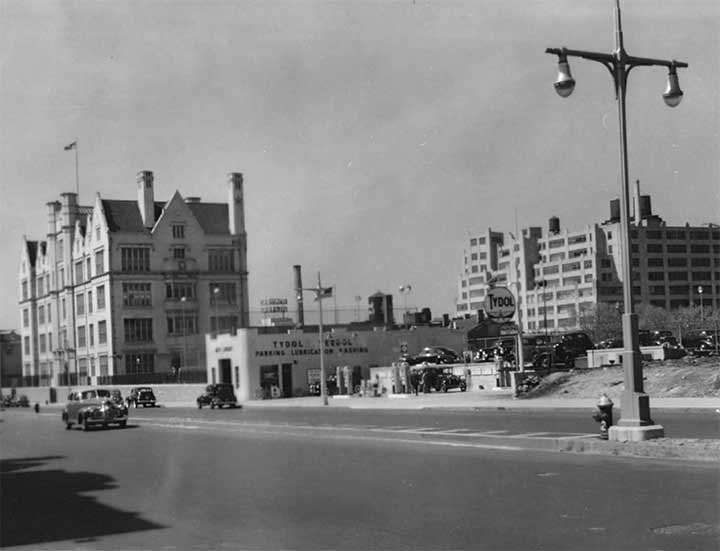
KNOWN as the Castle on the Concourse, the former PS 31 at the Grand Concourse and East 144th Street, south of Hostos Community College, was designed by NYC school architect C.B. J. Snyder in a Collegiate Gothic style and built in 1896. Though it was afforded Landmarked status by the Landmarks Preservation Commission in 1986, the school closed in 1997 and basically went unoccupied and uncared-for for the next 18 years until its demolition in 2015. Its site now hosts the tallest residential building with a Grand Concourse address. The site looks like this today.
The Tydol brand of gasoline was owned by the Tidewater Oil Company, which sold gasoline under the Tydol brand name from the 1920s through 1950s. After that Tidewater was folded into conglomerates Phillips 66 on the west coast and Getty on the east coast.
I had thought that Triborough Bridge-type lampposts were little used on regular city streets controlled by stoplights, but they did find a home on the Grand Concourse and Bruckner Boulevard in the Bronx until the 1950s, and in the 2000s, they were revived on major streets in Queens and the Bronx. Today, twin Corvingtons light the GC (whose full official name is the Grand Boulevard and Concourse).
As always, “comment…as you see fit.” I earn a small payment when you click on any ad on the site.
Photo: Al Ponte’s Time Machine
11/24/22


6 comments
From 1971 – 74 I was on the faculty at Morris High School, located about three miles away at E 166th St. and Boston Road. The Morris building opened in 1904, and is an excellent and preserved example of C.B. J. Snyder’s Collegiate Gothic style. Morris High School itself closed in 2002 but the building is still in use as the Morris Campus and houses four small specialty high schools. More historical information: https://en.wikipedia.org/wiki/Morris_High_School_(Bronx)
There are many famous Morris graduates; two are newsman Gabe Pressman and General and Secretary of State Colin Powell.
The Triborough Bridge-type lampposts were used on the Grand Concourse and Bruckner Boulevard because each one served as a major approach road to/from the bridge.
I think I’ll pass on seeing what they replaced it with.
This school is very much reminiscent in appearance of my days at the former PS160 in Manhattan, now a Latino cultural center. Amazing how things have changed but yet stayed the same.
Tidewater also sold gasoline under the Flying A brand.
Another Charles Snyder school, P.S.133 that occupied the corner of Butler St. & 4 Ave., Brooklyn was demolished circa 2010 to make way for current school at same location. Al Capone was a pupil there, and was held back at grade 6. A teacher struck him, and he hit her back. He was sent to principal’s office, and was hit by him. Alphonse never returned. My paternal grandfather was a student there, and took me to see the exterior in 1980’s during a walking tour. The loss of these great structures is very sad indeed. The building that replaced P.S.31 on The Grand Concourse sickened me.
P.S. 31 was an important part of the community as the staff provided an excellent education that was set in a beautiful, historic, building. I had cause to visit the building shortly before it was closed, and was delighted to find it was lovingly maintained inside and that it had a vibrant educational presence. Unfortunately, serious structural problems were discovered which led to the closing. For many years there was difficult discussion about spending the serious money that was needed to repair the 100 year-old building or use those funds for a new building which met modern teaching needs. Ultimately, the restoration cost proved too much (and the fact that the building had been left to decay exacerbated the problem). Often, buildings like schools, which were modern when designed a century before, do not meet today’s modern needs. Other buildings, like churches, may no longer be needed for the purposes for which they were built. The great challenge is to find adaptive reuse for such buildings, which does not happen often enough.